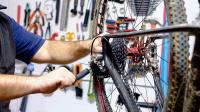Broken crank

As we examined the damage, it was obvious that along with the fresh clean break there was a darker area on the aluminium, suggesting there had been a fracture there for some time – maybe even from the day of manufacture. I know that the crank has not been subjected to any abuse as I have owned the bike from new. I have yet to find anyone else that this has happened to.
Keith Richards
It is unlikely that the crank was cracked from new. This break has all the signs of a fatigue fracture: the darker, smoother part is the zone of gradual crack growth and the rough, bright surface is the final tearing fracture. The origin of the crack will be a tiny flaw in the metal, perhaps an included fragment of foundry slag or a surface scratch, at which the stresses of your pedalling tended to concentrate, alternately pulling apart then closing up the metal around this flaw, until it became an actual crack.
This crack then grew slightly deeper into the metal with each subsequent reversal of strain, which became so great that another crack formed on the opposite side of the pedal hole. At this stage there should have been a visible hairline crack radiating from the side of pedal axle’s shoulder. It might have been possible to make it open slightly by standing on the 6 o’clock pedal, but you’d need an assistant to observe that. Finally, there wasn’t enough metal remaining to support your hill-storming lunge on the pedal.
Some metals, such as steel and titanium, are very resistant to the formation of cracks at surface flaws. But aluminium isn’t. It looks to me most likely that this crack started at the interface with the pedal shoulder. Some cranks come with thin steel washers to protect their surface against scoring by the pedal shoulder as it is tightened. I strongly recommend these washers with pedals where the spanner flats cut into the shoulder. It appears that your pedals, however, have a smooth circular shoulder, which I’d have thought unlikely to damage the crank enough to start a crack. The shoulder will nevertheless rub the surface upon tightening, whereas a washer might not.
Thirty years ago it would not have been hard to find someone who’d broken a crank. Some cranks had quite a reputation for fracturing at the pedal hole. But to be fair: at that time the use of lightweight alloy cranks was spreading from the cossetted realm of cycle sport to the knockabout world of travel and transport; and the end of a crank does tend to knock against things! So manufacturers always had an answer to complaints. Articles were written nevertheless, reporting that other cranks with more metal around the pedal hole didn’t seem as failure prone. When new designs of crank appeared they tended likewise to be fatter at the ends. I guess they were made thick enough that surface scratches shouldn’t matter anymore. And the problem went away.
This broken Sram crank, however, doesn’t swell visibly around the pedal hole and is somewhat reminiscent of those older, thinner designs…
Anyway: if you’re a big strong guy and like to stomp up hills, my advice is to use pedal washers even if your pedals don’t seem to need them, and choose heavy cranks that are especially meaty around the pedal hole.
Chris Juden
This was first published in the April / May 2014 edition of Cycling UK's Cycle magazine.